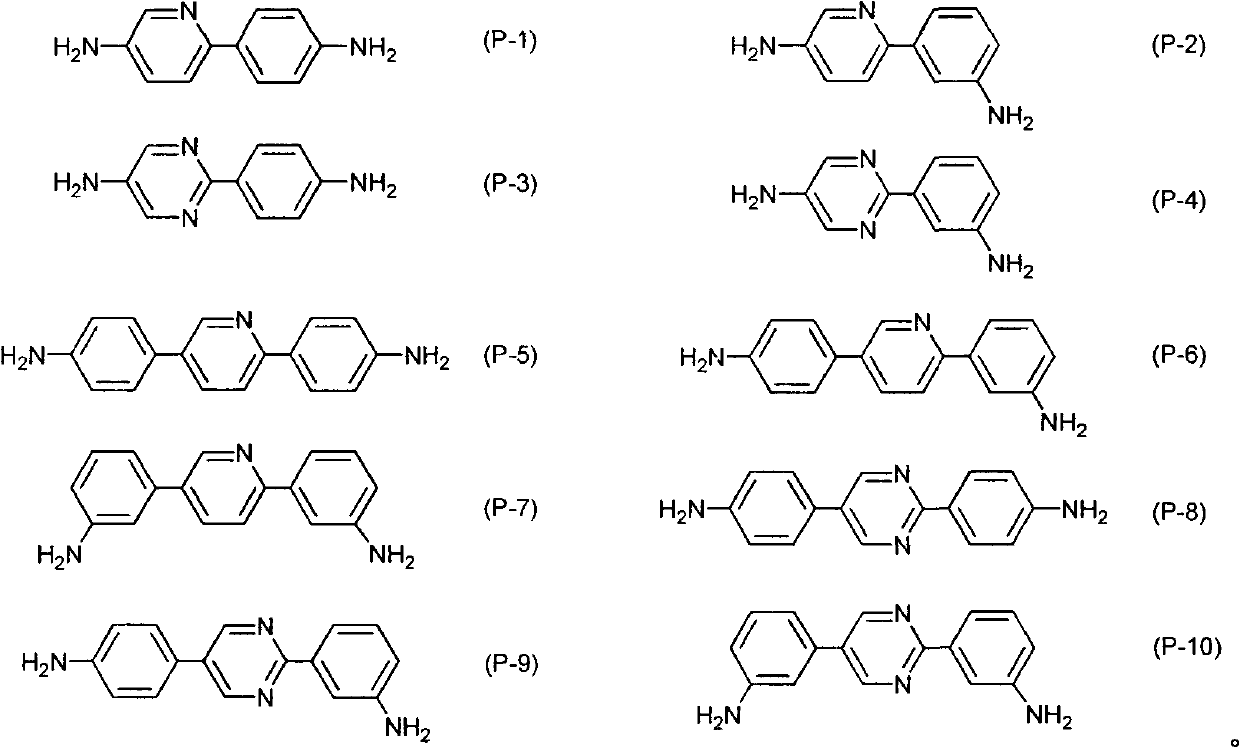Liquid crystal aligning agent, liquid crystal aligning film and liquid crystal display unit
A liquid crystal alignment agent and group technology, applied in liquid crystal materials, instruments, optics, etc., can solve the problems of halftone brightness inversion, narrow viewing angle of visual recognition image, reduced brightness or contrast, etc., and achieve the effect of low residual DC
- Summary
- Abstract
- Description
- Claims
- Application Information
AI Technical Summary
Problems solved by technology
Method used
Image
Examples
example
[0209] Examples are used to illustrate the present invention. In addition, the compounds used in the examples are shown below.
[0210]
[0211] Acid anhydride (H-1): pyromellitic dianhydride
[0212] Acid anhydride (S-1): 1,2,3,4-cyclobutanetetracarboxylic dianhydride:
[0213] Acid anhydride (S-48): ethylenediaminetetraacetic acid dianhydride:
[0214]
[0215] Diamine (P-5): 2,5-bis(4-aminophenyl)pyridine
[0216] Diamine (P-8): 2,5-bis(4-aminophenyl)pyrimidine
[0217] Diamine (V-1): 4,4'-Diaminodiphenylmethane
[0218] Diamine (V-7): 4,4'-diaminodiphenylethane
[0219] Diamine (VI-7): 1,4-bis(4-aminophenyl)-1,4-diazepine
[0220] Diamine (XII-2-1)(R 29 = N-heptyl): 1,1-bis(4-(4-aminophenylmethyl)phenyl)-4-n-heptylcyclohexane
[0221] Diamine (XII-4-1)(R 30 =n-pentyl): 1,1-bis(4-(4-aminophenoxy)phenyl)-4-(n-pentylcyclohexyl)cyclohexane
[0222] Diamine (XII-6-1)(R 30 = N-heptyl): 1,1-bis(4-(4-aminophenoxy)phenyl)-4-(2-(n-heptylcyclohexyl)ethyl)cyclohexane
[0223] DAPY: 2,6-Diaminopyridin...
Synthetic example 1
[0231] In a 100 mL four-necked flask equipped with a thermometer, a stirrer, a raw material input port, and a nitrogen gas introduction port, 1.673 g of diamine (P-5) and 30.0 g of dehydrated NMP were added, and the mixture was stirred and dissolved under a stream of dry nitrogen. Next, 0.6984 g of acid anhydride (H-1), 0.6280 g of acid anhydride (S-1), and 70.0 g of dehydrated NMP were added, and reacted for 15 hours in a room temperature environment. When the reaction temperature rises during the reaction, the reaction temperature is suppressed to about 70°C or less and the reaction proceeds. 10.0 g of BC was added to the obtained solution to obtain a polyamic acid solution having a concentration of 6 wt%. Let polyamic acid be PA1. The weight average molecular weight of PA1 is 27,300.
[0232] The weight average molecular weight of the polyamic acid is calculated by diluting the obtained polyamic acid with a phosphoric acid-DMF mixed solution (phosphoric acid / DMF=0.6 / 100, wei...
Synthetic example 2~12
[0234] The tetracarboxylic dianhydride and diamine were changed as shown in Table 1, and other than that, based on Synthesis Example 1, polyamic acid solutions (PA2) to (PA12) were prepared. Table 1 summarizes the results including Synthesis Example 1.
[0235]
[0236]
PUM
 Login to View More
Login to View More Abstract
Description
Claims
Application Information
 Login to View More
Login to View More - R&D
- Intellectual Property
- Life Sciences
- Materials
- Tech Scout
- Unparalleled Data Quality
- Higher Quality Content
- 60% Fewer Hallucinations
Browse by: Latest US Patents, China's latest patents, Technical Efficacy Thesaurus, Application Domain, Technology Topic, Popular Technical Reports.
© 2025 PatSnap. All rights reserved.Legal|Privacy policy|Modern Slavery Act Transparency Statement|Sitemap|About US| Contact US: help@patsnap.com



